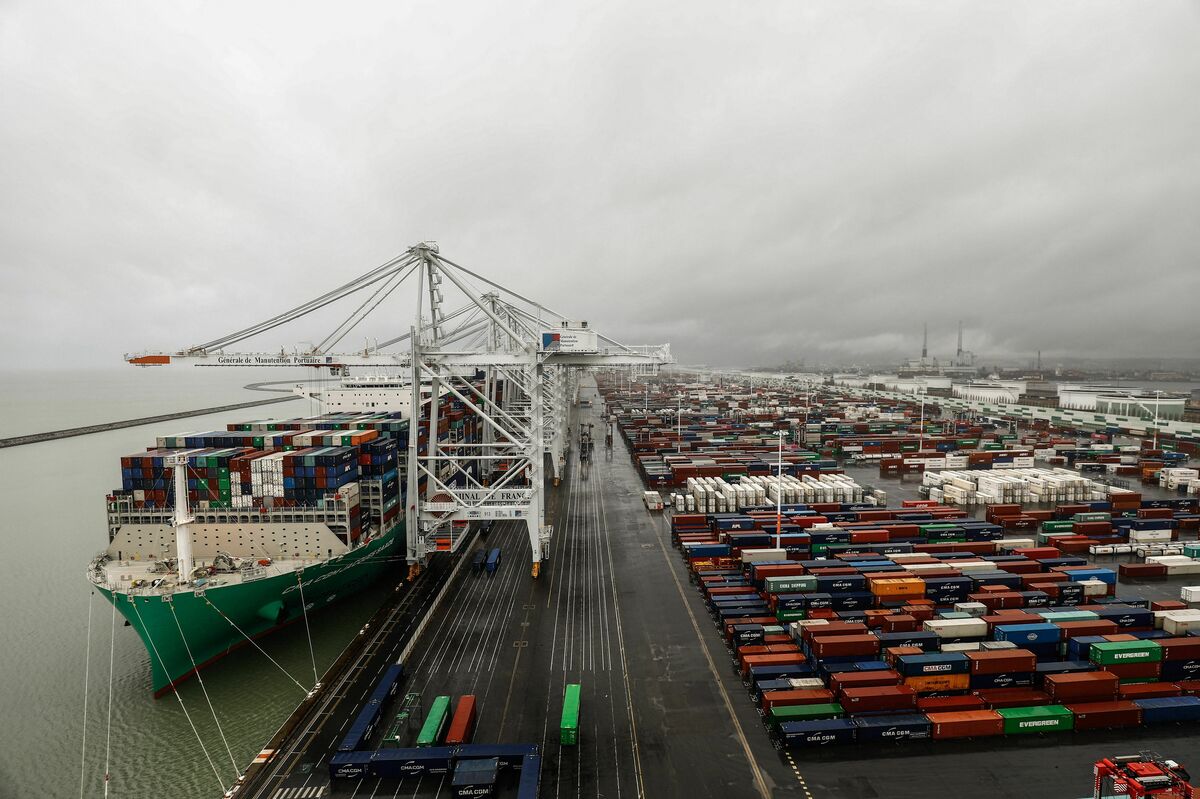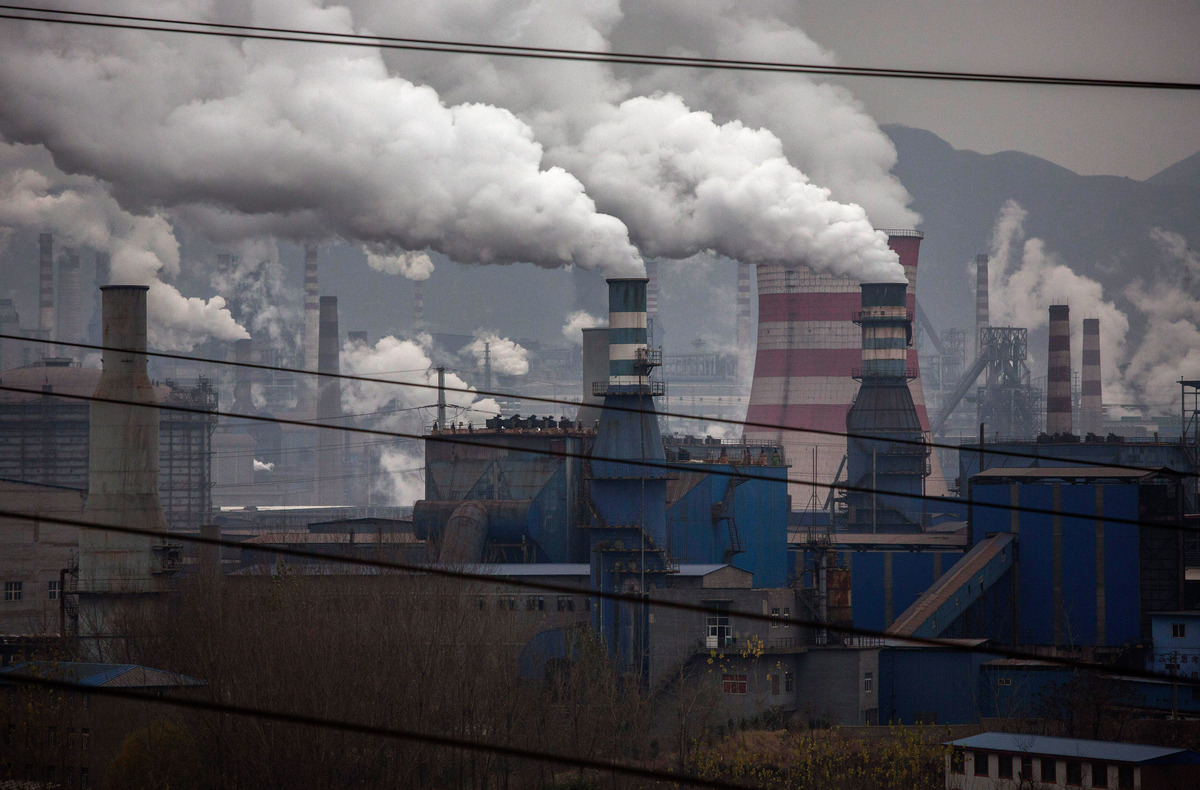The EU plans to tax certain imports based on the amount of carbon dioxide companies emit making them.
Sameer Al-Doumy /AFP via Getty Images
hide caption
toggle caption
Sameer Al-Doumy /AFP via Getty Images

The EU plans to tax certain imports based on the amount of carbon dioxide companies emit making them.
Sameer Al-Doumy /AFP via Getty Images
The European Union is ushering in a new era of international trade that could help rein in climate change. Lawmakers for the group of 27 countries adopted rules for taxing imports based on the amount of carbon dioxide that companies emit making those goods. Experts say it’s the first time a major economy has married climate and trade policy, and that it could lead other countries to do the same.
By putting a price on emissions from some of the stuff it imports — like steel and aluminum — the EU is giving companies around the world an incentive to clean up their operations.
Authorities won’t start collecting the tax for another few years, but the idea already seems to be catching on. In the United States, where climate change is often polarizing, Democrats and Republicans in Congress have begun talking seriously about what a similar policy in the U.S. might look like.
Could these sorts of policies actually help bring down carbon emissions? And what are the odds that U.S. lawmakers could be inspired to negotiate a similar deal to limit global warming? Here’s a look at the wonky but potentially useful tool for addressing climate change.
What’s behind the EU tax?
In 2005, the European Union instituted a cap-and-trade system for businesses as a way to cut the emissions that drive climate change. Under this program, power plants and factories that emit carbon dioxide have to buy so-called allowances to account for the damage they cause. It’s a way to make companies pay to pollute.
But the EU has been handing out free allowances to certain industries, because it was afraid that making companies pay the full cost of complying could drive them away to other countries with looser environmental rules. If that happened, EU emissions wouldn’t really fall — they’d just shift to other parts of the world — and Europe’s economy could suffer as businesses moved.
Now, the EU has decided to phase out the free allowances. At the same time, the bloc is introducing this new border tax on imports to make sure its companies aren’t at a disadvantage compared to manufacturers that can emit carbon dioxide for free.
So how will this EU border tax work?
That’ll depend on where companies are manufacturing their goods.
For a company in the U.S., EU regulators will look at the carbon pollution it generates making a product. Then the importer in the EU will be taxed for that pollution at the same rate a European company would pay for emissions under the cap-and-trade system.
The EU might account for regional or state carbon taxes that some companies pay, like those in California, says Chris Kardish, who focuses on industrial decarbonization at the Center for Climate and Energy Solutions.
So, the cost of some U.S. goods that are sold in the EU will almost certainly rise. But the price tag on things made in China, India and other developing countries will probably go up even more. That’s because companies there generate more climate pollution when they manufacture, since a larger share of electricity in the developing world comes from coal-fired power plants.
Experts say some details still have to be worked out. But in general, the fewer emissions that countries and companies emit when they’re making goods, the less they’ll pay in taxes when they sell to EU customers.
But it’s important to note that the EU won’t be taxing everything it imports. For now, the only goods subject to the memorably-named Carbon Border Adjustment Mechanism are iron, steel, cement, aluminum, fertilizers, electricity and hydrogen.
And the tax will be phased in slowly — over the course of nine years starting in 2026.


Smoke billows from smokestacks and a coal-fired power plant at a steel factory in China.
Kevin Frayer/Getty Images
hide caption
toggle caption
Kevin Frayer/Getty Images

Smoke billows from smokestacks and a coal-fired power plant at a steel factory in China.
Kevin Frayer/Getty Images
What sort of response is the EU expecting to its new policy?
The EU has been explicit that it’s trying to encourage countries outside the bloc to take more aggressive action on climate change.
The idea is that countries like China that burn a lot of coal to run their factories could be persuaded to cut emissions so their companies aren’t boxed out of the EU market. Meanwhile, countries like the U.S., which already have fairly strict environmental regulations, might also begin taxing the emissions linked to imports in order to protect their own domestic industries.
What Europe’s doing is a “very big deal,” says Greg Bertelsen, chief executive of the Climate Leadership Council, an advocacy group. He says that without incentives for cleaner manufacturing, “we simply will not get to where we need to get to, from a climate standpoint.”
So will the EU tax make a dent in global emissions?
That’ll depend on how countries and companies outside of the EU respond.
Manufacturers that do a lot of business with the bloc — or that would like to — might be spurred to cut emissions to make themselves more attractive to customers there.
And if other big economies start setting their own carbon border taxes or joining together in clubs to impose levies across borders, it could create a powerful incentive to cut emissions on a global scale.
But because international trade accounts for between 20% and 30% of global greenhouse gas emissions, even aggressive trade policies can only do so much to limit climate change.
“The emissions embedded in international trade, it’s not a majority, it’s a minority,” says Shuting Pomerleau, who researches climate policy at the Niskanen Center. “And I feel like lots of times, policymakers or analysts, they get a little carried away and overlook this fact.”
How is the U.S. thinking about this kind of policy?
Democrats and Republicans rarely agree on how the U.S. should respond to climate change. But this sort of tax isn’t just about cutting emissions.
Depending on how it’s structured, proponents say that taxing imported emissions could be a huge benefit to the U.S. economy, because it would remove incentives for companies to relocate to countries with laxer environmental rules.
“Companies may think twice about outsourcing a U.S. factory to a country with weaker standards if they know they’re going to have to pay a fee at the border to sell those products back in the United States,” says Ben Beachy, who works on manufacturing and industrial policy at the BlueGreen Alliance. “And properly designed, a polluter import fee could actually help re-shore manufacturing of the steel and aluminum that form the backbone of the clean economy.”
However, some say a border tax on its own isn’t enough. The U.S. needs to push companies to cut emissions even further so that they keep manufacturing things with less pollution than their overseas competitors, says Kardish of the Center for Climate and Energy Solutions.
Last year, Democrats floated a plan for a carbon border tax that would have also put a price on some domestic emissions.
But anything that’s seen as adding costs for American businesses could be hard to sell in Washington.
“This should be a policy that’s about leveling the playing field,” says Paul Cicio, chief executive of Industrial Energy Consumers of America, which represents manufacturers.


Workers at a steel mill in Indiana. In the U.S., some see a carbon border tax as a way to protect American manufacturers that generate less carbon pollution than their competitors overseas.
Scott Olson/Getty Images
hide caption
toggle caption
Scott Olson/Getty Images

Workers at a steel mill in Indiana. In the U.S., some see a carbon border tax as a way to protect American manufacturers that generate less carbon pollution than their competitors overseas.
Scott Olson/Getty Images
Is there really a chance the U.S. might start taxing imports based on climate pollution?
It depends on political negotiations, which can be pretty unpredictable. But lawmakers on both sides of the aisle are drafting plans for what they think such a border tax in this country could look like.
“Republicans and Democrats are coming to this issue from different angles. On the Democratic side, it tends to be climate interests that bring members into the discussion,” says Bertelsen of the Climate Leadership Council. “But on the Republican side, it actually tends to be economic interests and geopolitical interests that’s brought them into this discussion, with climate perhaps as a collateral benefit.”
Sen. Kevin Cramer, a Republican from North Dakota, told NPR that the best hope for getting the GOP on board is by focusing on what he called the “low-hanging fruit”: A carbon border tax that simply accounts for the costs that U.S. companies are paying to comply with existing regulations while punishing heavier polluters.
“I just know that to bring skeptical Republicans along, we need to have something pretty modest,” Cramer says.
Would any tax be better than no tax?
Not necessarily.
Some observers worry that if countries focus too much on protecting domestic industries, it could actually hurt global efforts to cut emissions.
“I’m concerned that there might be more trade conflicts among these major economies around the world — so, instead of embracing open economies and free trade, all these big players are embracing protectionist policies,” says Pomerleau of the Niskanen Center. “And so that might not be really helpful for solving climate change when global collaboration is really necessary.”
This story originally appeared on NPR

